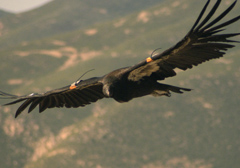
Debate continues over use of lead bullets in condor
territory
A possible ban on lead ammunition has sparked controversy both
locally and statewide. In recent weeks a statement by a group of
scientists and hunters agreeing lead ammunition poses a danger
California Condors has proponents of the ban cheering.
Debate continues over use of lead bullets in condor territory
A possible ban on lead ammunition has sparked controversy both locally and statewide. In recent weeks a statement by a group of scientists and hunters agreeing lead ammunition poses a danger California Condors has proponents of the ban cheering.
But those close to the condor recovery program in San Benito County say they will continue to emphasize education rather than jump on the ban’s political bandwagon.
“Would the park want to see less lead ammunition being used? We would love that,” Carl Brenner, Pinnacles supervisor of interpretation and education, said. “Our direction, however, is the educational side of this debate. We just want people to know there is a problem that exists out there, and to discuss how, as a community, we can work together to jointly come up with a solution.”
A statement of scientific agreement, released to the public July 11, was reached by a group made up of scientists, hunters, conservationists and landowners and was signed by 44 biologists. The group concluded lead ammunition is poisoning California condors and threatening the birds’ survival in the wild.
“The risk to condors is clear,” Graham Chisholm, director of conservation for Audubon California, said. “Removing lead from the condors’ environment is now the most important step we can take to save condors.”
Immediately following the statement’s release, several conservation groups, including Audubon California, Ventana Wildlife Society, Defenders of Wildlife, the University of California at Santa Cruz and Tejon Ranch called for a lead ammunition ban in condor habitat areas.
“In our lifetimes we have removed lead from paint and gasoline to protect human health,” Chisholm said. “Condors are powerful symbols of our state, and we urge the California Fish and Game Commission to embrace this simple action that can protect them, banning lead ammunition in condor country.”
Proposed legislation banning lead ammunition is currently working its way through the California Assembly – passage of AB821 would require the use of non-lead centerfire rifle and pistol ammunition within the Department of Fish and Game deer hunting zones in condor country.
Condors’ primary food sources are the dead carcasses of animals killed by other creatures of prey, including hunters. The debate became a local hot button in June2006, when 11 of the 13 condors roosting at Pinnacles National Monument at the time were found to have elevated lead levels in their blood after feeding on the remains of lead-shot squirrels.
Although many south county ranchers have switched to non-lead ammunition, others resented what they interpreted as an “order” by Pinnacles staff to stop using lead bullets.
Since then, Pinnacles park staff has worked steadily with local ranchers and hunters to educate them on the dangers of lead ammunition, Brenner said.
Pinnacles National Monument currently gives away free non-lead ammunition for anyone who is hunting in the region. But while lead-free ammunition is available for larger guns, it is not manufactured for .22 calibers and smaller guns used for “varmint” shooting. Proponents of banning lead bullets believe manufacturers would be compelled to create lead-free bullets for the smaller guns as well, but opponents of the ban say there is not a suitable alternative.
“It is environmentally irresponsible for us to allow condors to be poisoned, particularly because it is preventable,” said Kelly Sorenson, executive director of the Ventana Wildlife Society. “Hunters have been exceptional conservationists over time, and it is time again for us to lead and ensure that condors remain part of our ecosystem for years to come.”









